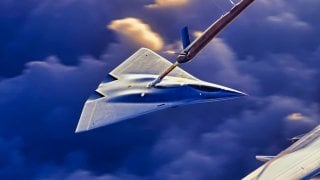Lockheed Martin Built the F-22 and F-35: NGAD Fighter Seems Next
Lockheed Martin is positioned as a likely frontrunner for the Next Generation Air Dominance (NGAD) program, a critical initiative set to replace the F-22 Raptor with a new sixth-generation fighter.
Summary: Lockheed Martin is positioned as a likely frontrunner for the Next Generation Air Dominance (NGAD) program, a critical initiative set to replace the F-22 Raptor with a new sixth-generation fighter.
-The program, aimed at developing a highly advanced "system of systems," includes plans for 200 NGAD fighters and 1,000 accompanying autonomous drones designed as "wingmen." Lockheed's recent tease of a potential NGAD design, showcasing a stealth-focused, tailless aircraft with engines integrated into the fuselage for enhanced stealth, aligns with its historical design philosophy.
-Despite competition from other aerospace giants and past challenges with the F-22 and F-35 programs, Lockheed Martin's track record in delivering cutting-edge military aircraft positions it strongly to secure this lucrative contract.
Lockheed Martin Eyes NGAD Contract: A New Era for U.S. Air Superiority
Last year, the Department of the Air Force began soliciting bids for the Next Generation Air Dominance (NGAD) program, a sixth-generation program that is slated to replace the F-22 Raptor. The NGAD contract is expected to be awarded sometime in 2024, leading observers to speculate which aerospace firm will land the lucrative contract.
The safe money is on Lockheed Martin, who won the bids that became both the F-22 and the F-35.
Lockheed Martin teases the shape of the NGAD bid
Lockheed Martin teased the shape of what could be their NGAD silhouette.
The image, shared on social media, could of course be a red herring, and may not actually be related to Lockheed Martin’s ultimate NGAD submission.
But the sixth-generation looking image is “similar to previous designs released by Lockheed Martin,” The Aviationist reported, “showing a tailless design (considered ideal to obtain very low observability) with a diamond-shaped wing platform with straight leading and trailing edges.”
The image was also distinct for featuring engines that were fully contained within the fuselage, a design that would further improve stealth characteristics.
As with many low-observable fuselage designs, the image showed an exhaust outlet located on the upper surface of the rear fuselage, “shielding almost completely the infrared signature of the two-dimensional diamond-shaped nozzles.” Additionally,, the air intakes are obscured, as they are mounted below the fuselage, “flush with the joint between wing root and fuselage.”
Lockheed Martin will have competition on NGAD
The NGAD contract is expected to be extremely lucrative.
As the Secretary of the Air Force noted, the USAF is expected to procure 200 NGAD fighters along with 1,000 CCA autonomous drones, which will function as “wingmen” for the NGAD fighters.
Each of the NGAD fighters is expected to cost multiple hundreds of millions of dollars and will operate as part of a “system of systems” that is highly connected with other assets, including the F-35, satellites, a combat network, and other air defense nodes – creating what should an immersive situational awareness.

Given the lucrative and prestigious nature of the contract, Lockheed Martin won’t be alone in pursuing a bid.
Expect rival firm Northrop Grumman to also compete, although they have said publically they are out of the competition. Boeing could compete, too, although the Seattle-based company has been suffering under the weight of multiple, egregious quality-related scandals.
But Lockheed Martin is the frontrunner after earning the US military’s two most recent fighter contracts. The first was for the Advanced Tactical Fighter (ATF) program. Lockheed’s YF-22 beat out Northrup’s YF-23 to earn the contract, in what has since become the F-22 Raptor. Then, Lockheed’s X-35 beat out Boeing’s X-32 for the Joint Strike Fighter contract, which has since become the F-35.
Neither the F-22 or F-35 production went smoothly – each have been criticized for delays and cost overruns. But each project ultimately resulted in a functional and impressive fighter jets envied by just about every air force on Earth today, which gave the US a technological advantage over rivals like Russia and China. That has to be a major selling point for Lockheed.
Given the expertise Lockheed Martin has demonstrated in crafting an impressive, cutting-edge fighter jet – and given the expertise Lockheed Martin has demonstrated in winning US military contracts – expect Lockheed Martin to be the frontrunner in securing the NGAD contract.
About the Author: Harrison Kass
Harrison Kass is a defense and national security writer with over 1,000 total pieces on issues involving global affairs. An attorney, pilot, guitarist, and minor pro hockey player, Harrison joined the US Air Force as a Pilot Trainee but was medically discharged. Harrison holds a BA from Lake Forest College, a JD from the University of Oregon, and an MA from New York University. Harrison listens to Dokken.


